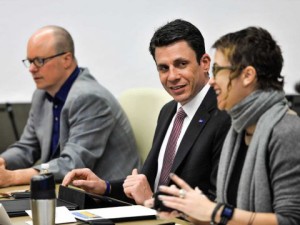#Leadership : ‘I Lost It’: The #Boss Who Banned Phones, and What Came Next… #Employers Limit Cellphone use to Regain Attentiveness. Workers use Watches and Laptops Instead.
Two thousand six hundred seventeen times a day. That is how often the average person taps, pokes, pinches or swipes their personal phone.
It all adds up to about 2 hours and 25 minutes, according to a study by mobile app research firm Dscout Inc. And a good chunk of that time comes during work hours.
Jason Brown had had enough of it. Two years ago, the chief executive of Brown, Parker & DeMarinis Advertising paused for a moment to look across the meeting room as he delivered a presentation. The majority of those gathered were fiddling with their phones.
“I lost it,” says Mr. Brown.
In his anger, he issued a companywide edict:“Don’t show up at a meeting with me with your phone. If someone shows up with their phone, it’ll be their last meeting.”
Many managers are conflicted about how—or even whether—to limit smartphone use in the workplace. Smartphones enable people to get work done remotely, stay on top of rapid business developments and keep up with clients and colleagues. But the devices are also the leading productivity killers in the workplace, according to a 2016 survey of more than 2,000 executives and human-resource managers conducted by CareerBuilder, an HR software and services company.
Like this Article? Share It ! You now can easily enjoy/follow/share Today our Award Winning Articles/Blogs with Now Over 2.5 Million Growing Participates Worldwide in our various Social Media formats below:
FSC LinkedIn Network: www.linkedin.com/in/fscnetwork
Facebook: http://www.facebook.com/pages/First-Sun-Consulting-LLC-Outplacement-Services/213542315355343?sk=wall
Google+: https://plus.google.com/115673713231115398101/posts?hl=en
Twitter: Follow us @ firstsunllc
Question: Want the ‘the best/current articles/blogs on the web’ on Job Search, Resume, Advancing/Changing your Career, or simply Managing People?
Answer: Simply go to our FSC Career Blog below & type(#career, #leadership, #life) in Blog Search:https://www.firstsun.com/fsc-career-blog/
What Skill Sets do You have to be ‘Sharpened’ ?
Continue of article:
There is also some evidence that productivity suffers in the mere presence of smartphones. When workers in a recent study by the University of Texas and University of California had their personal phones placed on their desks—untouched—their cognitive performance was lower than when their devices were in another location, such as in a handbag or the pocket of a coat hanging near their workspace.
“I firmly believe that multitasking is a myth,” says Bill Hoopes, an IT project manager at L3 TechnologiesInc.
Mr. Hoopes put his convictions into practice at group gatherings when he took over a team of about 25 people at the aerospace defense company three years ago. “Every time someone’s phone went off, they had to stand for the rest of the meeting,” he says. Before long, he asked the group to leave their phones at their desks when two or more people got together.
Over time, he says, he has noticed not only an improvement in the quality of conversation and ideas in meetings, but also that his people seem to show more respect and appreciation for one another’s work.
Mat Ishbia, CEO of United Wholesale Mortgage, banned technology from meetings about two years ago and recently asked that his executive team and other managers not check their phones as they walk to and from meetings.
Mr. Ishbia is now piloting another solution to phone addiction. A group of about 250 workers are part of an experiment in which they refrain from all personal phone use at their desks. If they want to use their devices they must go to a common area designated for phone use and socializing. Forty-five days into the trial run, workers are checking their phones a lot less, he said.
Bryan Lee, a product manager at enterprise software company Docker Inc., suspected that his daily phone use was a problem, so last month he installed an app called Moment on his iPhone that tracks the total amount of daily time he spent on his phone. His first measurement revealed four hours in a day. Since early April, he’s reduced that to roughly an hour.
At work, Mr. Lee persuaded his team of eight to download the app and post their daily phone hours on a whiteboard. The team member with the lowest time gets bragging rights.
“We’re thinking of having a trophy we can pass around—or maybe just shaming the loser,” he says.
Handheld devices can be a valuable source of information during office gatherings. Shane Wooten, CEO of enterprise video platform company Vidplat LLC, recently surprised a group of corporate clients with a request that they leave their electronic devices outside. “They didn’t like it,” he says.
Since January, Mr. Wooten has limited personal devices at meetings with his employees and faced some resistance. Workers argue their phones are vital for staying in touch with a sick child or researching information relevant to the meeting.
“I told them we’re not in middle school,” he says. “I’m not collecting phones in a bucket. Just don’t have it out faceup on the table.”
Google Inc. announced last week that the next version of its operating system for Android phones will include a feature that is meant to help people who feel tethered to their devices. It will let users see how much time they spend on their phones, show which apps they use the most and display how often the phone gets unlocked.
Instead of phones, staffers wore smartwatches to meetings or brought their laptops, which were just as distracting, he says, adding that workers said they were worried about missing calls and emails from clients.
Now, he tells his 40 employees not to attend meetings unless they really have to be there and strongly advises they fully engage.
Mr. Brown missed his phone too and likened the experience to outlawing alcohol during the Prohibition era: “A theoretical state that almost no one wants to live in, including those making the rules,” he says.
Write to John Simons at John.Simons@wsj.com
WSJ.com | May 17, 2018 | John Simons
[/fusion_builder_column][/fusion_builder_row][/fusion_builder_container]


